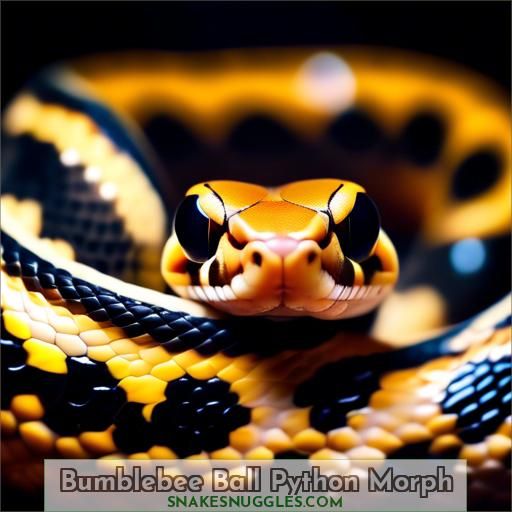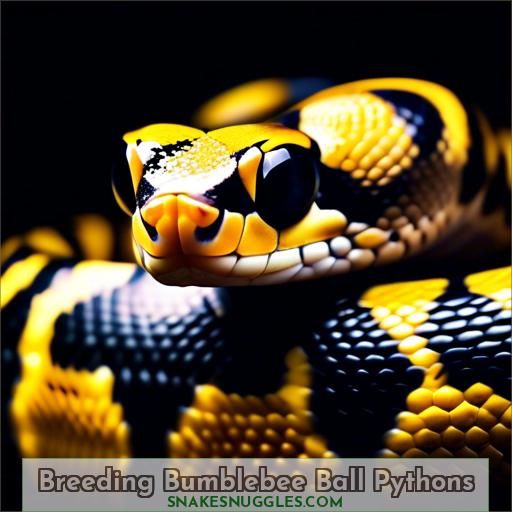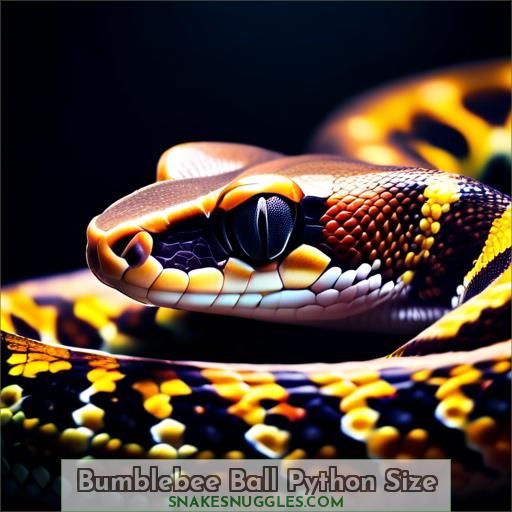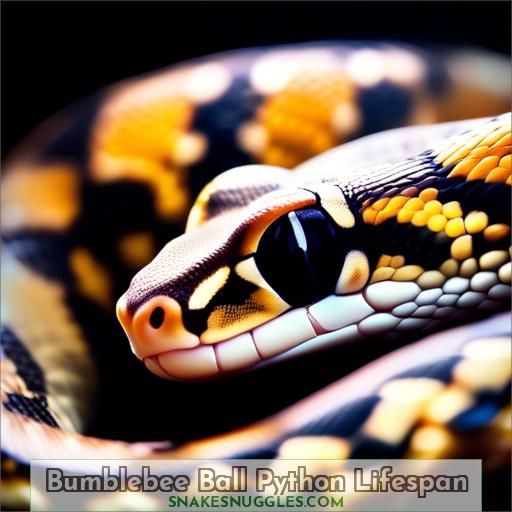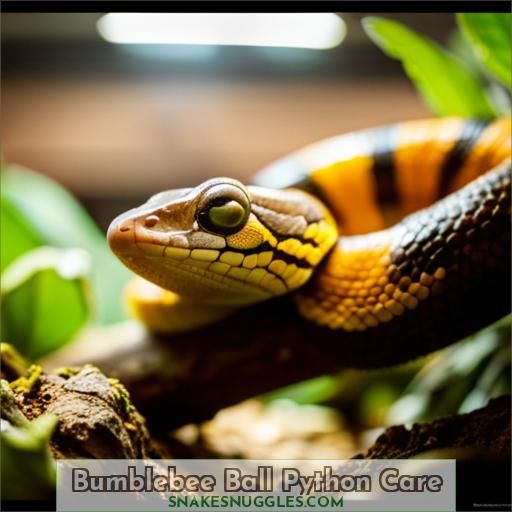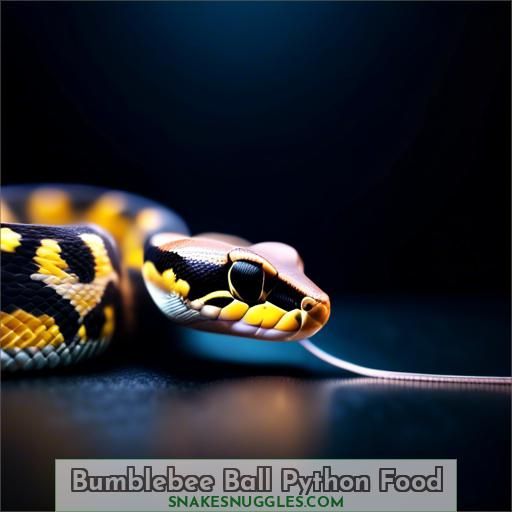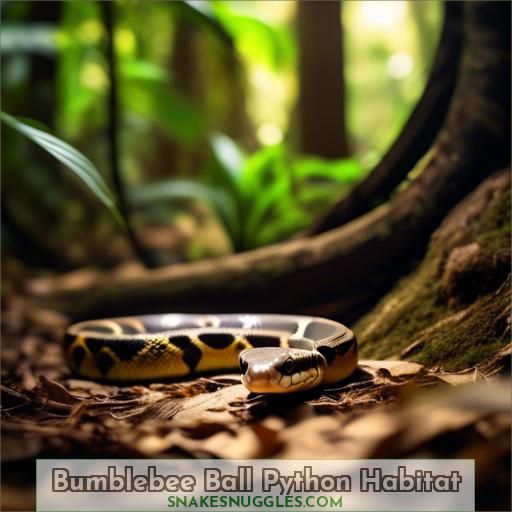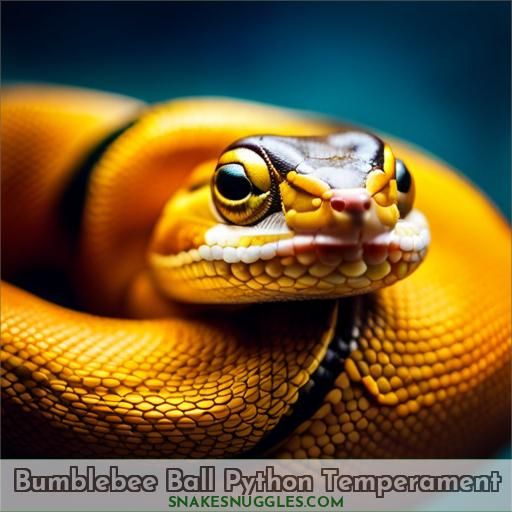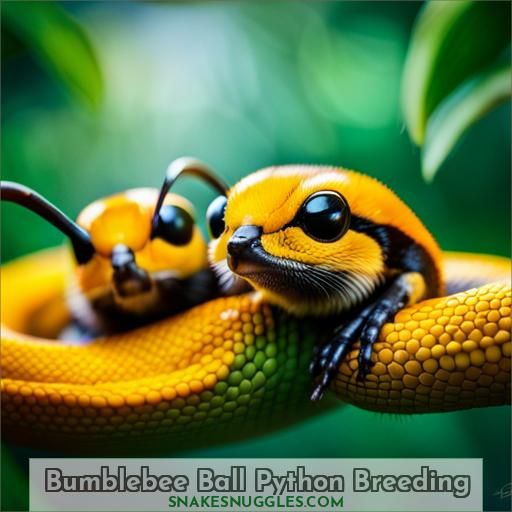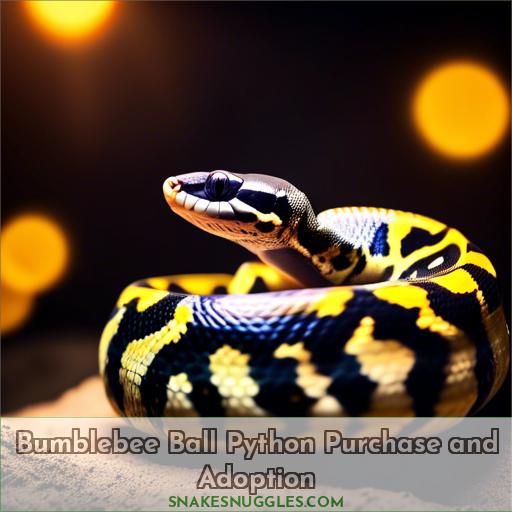This site is supported by our readers. We may earn a commission, at no cost to you, if you purchase through links.
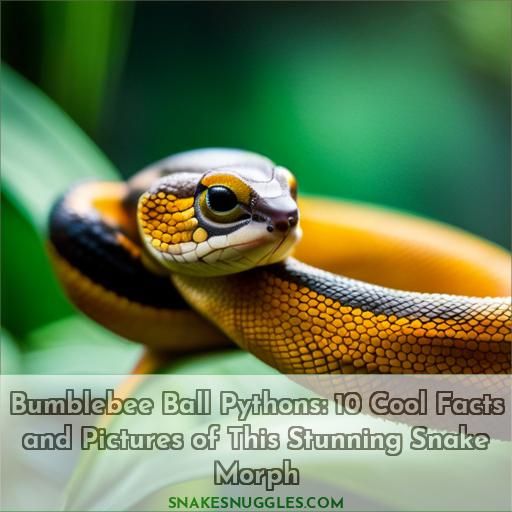 Ready to discover 10 cool facts about bumblebee ball pythons? These unique snakes boast striking yellow and black coloration, making them a must-see for reptile enthusiasts. Here are some key points to know:
Ready to discover 10 cool facts about bumblebee ball pythons? These unique snakes boast striking yellow and black coloration, making them a must-see for reptile enthusiasts. Here are some key points to know:
- Bumblebee Ball Python Morph: Combines Pastel and Spider genes to create a unique appearance.
- Breeding Bumblebee Ball Pythons: A recessive trait that requires compatible mates with identical genetic makeup.
- Bumblebee Ball Python Size: Typically 3-5 feet long, with females larger than males, and can reach up to 6 feet in length.
- Bumblebee Ball Python Lifespan: Can live up to 20 to 30 years in captivity.
- Bumblebee Ball Python Care: Requires a suitable habitat, temperature gradient, and specific care, including feeding frozen rodents and monitoring humidity levels.
- Bumblebee Ball Python Food: Feed frozen rodents appropriate for size and age.
- Bumblebee Ball Python Habitat: Suitable habitats include plastic sweaterboxes, melamine racks, or reptile cages.
- Bumblebee Ball Python Temperament: Can be docile and friendly with proper handling and care.
- Bumblebee Ball Python Breeding: Captive breeding aids in follicle development and egg production.
- Bumblebee Ball Python Purchase and Adoption: Be prepared for unexpected expenses, patience, and dedication when adopting a bumblebee ball python.
If you’re intrigued, there’s more to learn about these fascinating creatures!
Table Of Contents
- Key Takeaways
- Bumblebee Ball Python Morph
- Breeding Bumblebee Ball Pythons
- Bumblebee Ball Python Size
- Bumblebee Ball Python Lifespan
- Bumblebee Ball Python Care
- Bumblebee Ball Python Food
- Bumblebee Ball Python Habitat
- Bumblebee Ball Python Temperament
- Bumblebee Ball Python Breeding
- Bumblebee Ball Python Purchase and Adoption
- Frequently Asked Questions (FAQs)
- Conclusion
Key Takeaways
- Bumblebee ball pythons are a unique morph combining the Pastel and Spider genes, resulting in their distinctive yellow and black coloration that resembles a bumblebee.
- These snakes have a docile temperament, making them suitable pets for both novice and experienced reptile enthusiasts.
- They require specific care, including a suitable habitat with a temperature gradient, appropriate feeding of frozen rodents, and monitoring of humidity levels.
- Bumblebee ball pythons can live up to 20 to 30 years in captivity, highlighting the long-term commitment required for their care.
Bumblebee Ball Python Morph
The Bumblebee Ball Python is a morph that combines the Pastel and Spider genes, creating a stunning visual display of yellow and black coloration. This unique morph is a result of breeding a Pastel Ball Python to a Spider Ball Python, creating a triple threat morph that produces three different morphs when bred to normal females: Bumblebees, Spiders, and Pastel Jungles.
The Bumblebee Ball Python’s genetic inheritance is co-dominant, meaning there are multiple ways to produce this morph. You can breed a Pastel Ball Python or Super Pastel Ball Python to a Spider Ball Python, or breed a Bumblebee or Killer Bee to a normal, pastel, or spider. The spider gene and pastel gene must be present in one or both parents to have a one in four or higher chance of getting a baby Bumblebee Ball Python in the clutch.
The Bumblebee Ball Python’s striking yellow and black coloration is a result of line breeding, where specific individuals with different appearances are bred to create a specific coloration and pattern. This morph has gained popularity due to its genuine beauty and amazing disposition, making it one of the best-selling morphs in the ball python world.
Breeding Bumblebee Ball Pythons
Breeding bumblebee ball pythons is an intriguing process that entails meticulous planning, monitoring, and comprehension of the snake’s genetics. As a conscientious pet owner, you’ll desire to safeguard the well-being of your snake throughout the breeding process.
Primarily, it’s imperative to grasp the genetics of bumblebee ball pythons. This morph is a recessive trait, signifying that both parents must possess the gene for the bumblebee pattern. If you’re contemplating breeding your bumblebee ball python, you’ll need to locate a mate with an identical genetic makeup.
Upon finding a compatible mate, the breeding process commences. Female ball pythons are generally bred once annually, and the breeding season fluctuates. To stimulate breeding, you can diminish the temperatures for a brief period to imitate the natural breeding season, but this isn’t mandatory. Females are prepared when they’re ready, and breeding males are introduced when follicles are detected.
Subsequent to breeding, the female will deposit eggs, which must be incubated under the appropriate temperature and humidity conditions. The hatch rate may vary, but with adequate care, you can anticipate a considerable number of healthy hatchlings.
During the incubation period, it’s paramount to maintain the correct temperature and humidity levels to ensure the well-being of the eggs. Once the eggs hatch, the babies will require a suitable enclosure and proper care, encompassing feeding and monitoring their health.
Breeding bumblebee ball pythons can be a fulfilling experience, but it necessitates patience, knowledge, and dedication. By adhering to these guidelines and ensuring the health and well-being of your snakes, you can successfully breed these magnificent creatures and contribute to the preservation of their species.
Bumblebee Ball Python Size
Bumblebee Ball Pythons are renowned for their distinctive appearance and vivid colors, making them a favored choice among snake enthusiasts. These snakes typically attain lengths of 3-5 feet as adults, with females surpassing males in size. However, some individuals have been documented to reach lengths of up to 6 feet. Bumblebee Ball Pythons can live for 30 years or more, with some individuals surviving for 40 years or more.
When it comes to providing care for Bumblebee Ball Pythons, size is a paramount factor to bear in mind. These snakes require enclosures that are suitable for their size. For instance, hatchlings can be comfortably accommodated in a shoebox-sized enclosure, but as they mature, they’ll necessitate larger enclosures. As adults, Bumblebee Ball Pythons should be housed in a 30-gallon tank with a securely fastened screen top.
Bumblebee Ball Pythons have specific dietary requirements. Infants will consume fuzz mice, while juveniles can consume fully weaned mice or baby rats**. Adults favor rats. It’s essential to feed these snakes appropriately to guarantee their growth and well-being.
In terms of handling, Bumblebee Ball Pythons are generally docile and can be handled with caution. However, they should be treated with respect and handled gently to avoid causing stress or injury.
Bumblebee Ball Pythons require specific temperature and lighting conditions to maintain their health. They need a thermal gradient of 88-96°F hotspot, 78-80°F ambient, and a minimum of 75°F. It’s imperative to maintain these temperatures to guarantee the snake’s well-being.
Breeding Bumblebee Ball Pythons is a complex process that necessitates meticulous monitoring and management. Females breed once annually, and the breeding season can vary. Lowering temperatures doesn’t induce the breeding season, and breeders have eggs year-round in the UK. It’s essential to comprehend the breeding cycle and provide the appropriate conditions for successful breeding.
Bumblebee Ball Python Lifespan
The Bumblebee Ball Python Morph is a stunning snake with high-contrast black and yellow bands. This morph has a lifespan of 20 to 30 years in captivity, which is comparable to other Ball Python morphs.
The lifespan of the Bumblebee Ball Python is influenced by factors such as genetics, diet, and enclosure conditions. Captive breeding has allowed for year-round breeding, which aids in follicle development and egg production.
However, breeding challenges can arise, such as unexpected bills that may delay breeding plans, males going off feed during the breeding season, and females being more stressed by the breeding process. Males can be reused as long as they aren’t overbred, and females require more time to recover from breeding.
Bumblebee Ball Pythons are known for their vibrant colors and unique patterns, making them a popular choice among reptile enthusiasts.
Bumblebee Ball Python Care
As a conscientious and committed snake owner, you’re constantly seeking up-to-date knowledge on how to deliver the optimal care for your Bumblebee Ball Python. You’ve become familiar with the diverse morphs and their unique traits, and you’re keen to expand your understanding of breeding these captivating creatures. However, before embarking on the journey of snake breeding, you desire to grasp the fundamentals of Bumblebee Ball Python care.
Foremost, it’s imperative to bear in mind that Bumblebee Ball Pythons, like all ball pythons, are widely kept as pets due to their size and demeanor. Nevertheless, they necessitate specific care to safeguard their health and well-being. A critical component of care involves providing a suitable habitat. Bumblebee Ball Pythons can be accommodated in various enclosures, such as plastic sweaterboxes, melamine racks, or reptile cages. Regardless of the enclosure, it’s essential to offer a secure hiding place for your snake to feel secure and at ease.
Regarding temperature, Bumblebee Ball Pythons, like other ball pythons, have particular temperature requirements. A temperature gradient of 88-96°F for the hotspot, 78-80°F for the ambient temperature, and a minimum of 75°F is crucial for their health. Heat emitters, basking bulbs, or undercage heating pads can be employed to uphold these temperatures. Remember to monitor the temperature with a digital thermometer to ensure your snake’s comfort.
When it comes to feeding your Bumblebee Ball Python, you’ll want to provide a diet that’s appropriate for their size and age. Hatchlings should be started on small prey items, while adults can be fed larger rodents. It’s also important to monitor your snake’s humidity levels, as they play a significant role in their overall health.
Bumblebee Ball Python Food
Providing nourishment for your bumblebee ball python is a crucial aspect of its care. Comprehending the nutritional requirements of your snake will contribute to its well-being and optimal health in its habitat. Here are some salient considerations regarding the dietary needs of bumblebee ball pythons:
- Frozen Rodents: Bumblebee ball pythons predominantly consume frozen rodents, such as mice and rats. These should be thawed prior to feeding to ensure they’re innocuous and effortless for your snake to ingest.
- Frequency: The frequency of feeding for bumblebee ball pythons varies based on their age, size, and level of activity. Younger snakes should be fed weekly, while mature snakes require nourishment only every 1-2 weeks. Infant snakes can be fed every other day.
- Prey Size: The size of the prey should approximate the width of the snake at its midsection. For example, if the snake’s midsection measures 1 ½” in diameter, its prey shouldn’t exceed 1 ½” in width.
- Feeding Schedule: Bumblebee ball pythons are nocturnal feeders, so offer sustenance during nighttime hours and employ feeding tongs instead of bare hands to prevent injury.
- Fresh Water: Ensure the availability of fresh, clean water for your snake’s hydration. Replace the water daily to maintain its hygiene.
Bumblebee Ball Python Habitat
Establishing the optimal living space for your Bumblebee Ball Python is paramount for its health and well-being. These snakes are renowned for their distinctive patterns and docile nature, and they necessitate an appropriate environment to flourish.
Firstly, let’s discuss enclosures. Bumblebee Ball Pythons can inhabit various enclosures, including plastic sweaterboxes, melamine racks, or reptile cages. The enclosure’s size should be commensurate with the snake’s age. For juveniles, diminutive enclosures are suitable, whereas adults require more spacious areas.
Humidity is another pivotal factor in their habitat. Monitoring humidity is imperative for their health, so maintain the enclosure at approximately 50-60% humidity. Employing a water dish or a humid hide box can help achieve this level.
Regarding substrate, refrain from using sand or gravel, as these materials can lead to impaction if ingested. Opt for paper towels, coconut fiber, or cypress mulch instead.
Cohabitation is generally not advisable for Bumblebee Ball Pythons, as they can be territorial and antagonistic towards their own species. It’s prudent to house them in separate enclosures.
Enrichment is also indispensable for their mental and physical well-being. Provide concealed areas, climbing structures, and objects for them to investigate. This will enhance their comfort and mitigate stress.
Bumblebee Ball Python Temperament
Bumblebee Ball Pythons are known for their friendly and easy-to-handle temperament, making them an excellent choice for beginner snake handlers. These snakes are relatively calm and have a laid-back personality, similar to other ball python morphs. They aren’t large in size, which contributes to their manageability.
Handling a Bumblebee Ball Python:
The key to handling a Bumblebee Ball Python is to start early and often, as this will get them used to human interaction. Begin with short handling sessions and gradually increase the duration. It’s essential to wait at least 2 days after feeding before handling, as the snake may regurgitate its meal.
Bumblebee Ball Python Activity Patterns:
Bumblebee Ball Pythons are active during the day and night, but they tend to be more active during the day. They’re also known to climb, making them suitable for enclosures with branches or other climbing structures.
Shedding and Health Issues:
Like all reptiles, Bumblebee Ball Pythons shed their skin regularly as they grow. A healthy snake should shed its skin in one piece once every 4-6 weeks. If your snake is having trouble shedding, you can create a humidity chamber to facilitate a successful shed.
Bumblebee Ball Python Popularity:
The popularity of Bumblebee Ball Pythons is due to their striking yellow coloration and friendly demeanor, making them a favorite among ball python enthusiasts worldwide. Their popularity has contributed to the development of other ball python morphs, such as the Spinner Bee and Killer Bee, which also exhibit high-contrast black and yellow bands.
Bumblebee Ball Python Breeding
Breeding bumblebee ball pythons can be a thrilling experience for reptile enthusiasts. These snakes have a unique set of needs and characteristics that make them a fascinating species to work with. Here’s what you need to know about breeding bumblebee ball pythons:
Breeding Season:
Bumblebee ball pythons, like many other reptiles, don’t have a specific breeding season. They can breed at any time of the year, but the breeding season can vary depending on the individual snake’s readiness and environmental conditions. Lowering temperatures doesn’t necessarily induce the breeding season, as some breeders have eggs year-round in the UK. It’s essential to observe the snakes’ behavior and readiness before attempting to breed them.
Controlled Temperatures:
Bumblebee ball pythons are cold-blooded and rely on their environment to regulate their body temperature. In the wild, they’re regulated by temperature and photo period. Captive breeding allows for year-round breeding, but dropping temperatures can aid in breeding and follicle development. Females are cooled at specific times each season to encourage breeding.
Unexpected Expenses:
Breeding bumblebee ball pythons can be costly, as unexpected bills may arise during the breeding process. These costs can include veterinary care, food, and equipment for proper housing and temperature control.
Female Stress:
Female bumblebee ball pythons are more stressed by breeding than males. It’s important to make sure the females are comfortable and well-fed before breeding to minimize stress.
Male Stamina:
Males regain their stamina quickly with small meals, while females require more time to recover.
Bumblebee Ball Python Purchase and Adoption
If you’re ready to add a Bumblebee Ball Python to your collection, you’re in luck! These snakes are available for purchase and adoption from various sources. You can find them at pet stores, breeders, expos, and online shops. Captive-born and bred specimens are preferred, and well-established snakes that are eating well are ideal.
When it comes to the cost of acquiring a Bumblebee Ball Python, prices can vary depending on the age and condition of the snake. For example, an adult female Bumblebee Ball Python can cost around $299.99. Hatchlings may be available for a lower price, but keep in mind that their size can range from 10 inches to 5 feet when fully grown.
If you’re looking for a specific morph or pattern, such as the Bumblebee Ball Python, you can find a variety of options. These snakes are the result of breeding a Spider Ball to a Pastel Ball, and they exhibit two traits at one time, making them a popular choice among ball python enthusiasts.
Remember to choose a reputable breeder or supplier to guarantee the health and well-being of your new pet. Always ask about the snake’s diet, enclosure size, and any specific care requirements. With proper care and attention, your Bumblebee Ball Python can be a wonderful addition to your home for many years.
Frequently Asked Questions (FAQs)
Can bumblebee ball pythons recognize their owners?
Ball pythons, including the bumblebee morph, are known for their ability to recognize their owners. They’re intelligent and can learn to associate their keepers with food and other positive experiences. This recognition is essential for the emotional well-being of the snake and can aid in the process of handling and caring for them.
How do bumblebee ball pythons react to music?
Bumblebee ball pythons are renowned for their distinctive combination of two dominant morphs, namely the pastel and spider ball python. They’re widely sought after by reptile enthusiasts due to their captivating appearance and intriguing traits.
Regarding their response to music, scant information is available. The majority of sources concentrate on their susceptibility to noise and vibrations, which could be a concern for owners who indulge in loud music or possess drum sets. Although it’s known that snakes have the ability to perceive music, whether they’re influenced by it or not may vary according to the species and the individual snake.
Consequently, it’s imperative to take into account the particular requirements of your bumblebee ball python and guarantee that its environment is conducive to its welfare.
Are bumblebee ball pythons active during the day?
Bumblebee ball pythons are active during the day, but they’re primarily nocturnal animals. They spend their days in their hides and become more active at night, roaming around their enclosures. However, over time, they can adapt to being active during the day as well.
What are common health issues in bumblebee ball pythons?
Common health issues in bumblebee ball pythons include mouth rot, a bacterial infection of the mouth, and mite infestations. Mouth rot can occur when debris or food gets stuck in the snake’s mouth, if the snake’s mouth has become injured, or if the snake strikes at the enclosure. Symptoms include bright red spots or spots on the snake’s gums, excessive salivation, or a yellowish cheesy substance in the snake’s mouth. Ball pythons suffering from mouth rot may also refuse food.
Mite infestations can cause your larger ball python to stop eating and a smaller ball python to die from severe anemia. There are commercially available products specifically developed for mite removal, but be sure to read the directions and follow them exactly. If you’re unable to rid your snake of mites, seek veterinary care.
How do seasonal changes affect bumblebee ball pythons?
Seasonal changes can notably influence bumblebee ball pythons, especially during the mating season. Females are known to mate once a year, and the mating season varies. Lowering temperatures doesn’t trigger the mating season, and breeders have eggs all year in the UK. However, it’s uncertain if mating year-round is advisable.
Breeding males are introduced when follicles are detected, and females are ready when they’re ready. Wild ball pythons are regulated by temperature and day length, and captive breeding permits year-round breeding. Falling temperatures assist breeding and follicle development, and females are cooled at specific times each season.
Males can be reused as long as they aren’t overbred. Unforeseen expenses can postpone breeding plans, males may stop eating during the breeding season, females are more affected by breeding than males, and males regain energy quickly with small meals, while females need more time to recuperate.
Conclusion
Envision a garden teeming with life, a realm where every inhabitant fulfills a distinct purpose. Within this vibrant tapestry, the bumblebee ball python emerges as a captivating presence, not merely due to its striking yellow and black hues but also for its intriguing attributes.
These 10 intriguing facts concerning bumblebee ball pythons shed light on their breeding, care, and more, rendering them essential knowledge for reptile aficionados:
- Unique Coloration: The bumblebee ball python’s distinctive yellow and black pattern is the result of a genetic mutation that produces a striking resemblance to the iconic bumblebee.
- Docile Temperament: Ball pythons, in general, are known for their calm and docile nature, making them popular pets. The bumblebee variant shares this trait, making it an excellent choice for both novice and experienced reptile enthusiasts.
- Moderate Size: Bumblebee ball pythons typically reach a length of 3-5 feet, making them a manageable size for most reptile owners.
- Specialized Care Requirements: Like all ball pythons, bumblebees require specific environmental conditions, including appropriate temperature, humidity, and hiding spots, to thrive in captivity.
- Breeding Challenges: Producing bumblebee ball pythons can be a complex process, as the trait is recessive. Experienced breeders must carefully select and pair individuals to increase the likelihood of offspring inheriting the desired coloration.
- Genetic Variations: In addition to the classic bumblebee pattern, selective breeding has resulted in various genetic variations, such as the super bumblebee, which features an even more pronounced yellow and black contrast.
- Feeding Habits: Bumblebee ball pythons, like their counterparts, are primarily carnivorous and feed on appropriately sized rodents, such as mice or rats, in captivity.
- Shedding Process: Ball pythons, including the bumblebee variant, regularly shed their skin as they grow, a process that requires careful monitoring and humidity control to ensure a successful shed.
- Lifespan: With proper care and housing, bumblebee ball pythons can live for 20-30 years in captivity, making them a long-term commitment for their owners.
- Conservation Efforts: While ball pythons are not currently considered endangered, responsible breeding and captive management practices are essential to maintain healthy populations and prevent overharvesting from the wild.

